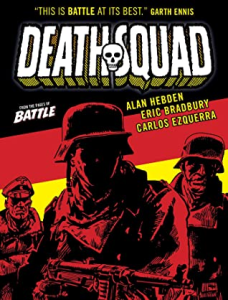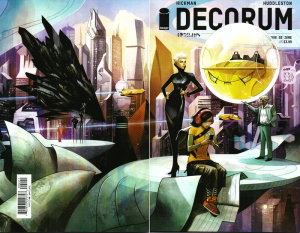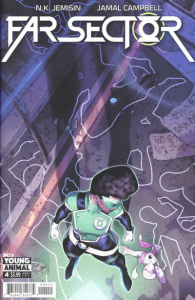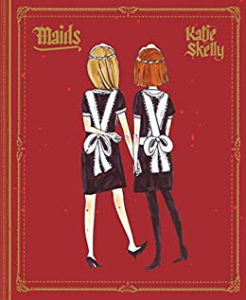If you read last week’s post, you know what’s going on. Here are another handful of cool comics that came out in 2020:
BOY MAXIMORTAL
Rather than an iconoclastic anomaly, R-rated super(anti)heroes have become a staple of mainstream pop culture, including a recent string of acclaimed shows, such as Jessica Jones, Watchmen, and The Boys (there was also a TV version of Powers, but I didn’t catch it). In comics, this subgenre has more than three decades, yet few works have matched the ambition and originality of Rick Veitch’s 1992-1993 limited series The Maximortal. An example of superhero horror if there ever was one, The Maximortal mixed a fucked up version of Superman (here an amoral idea come to life, called True-Man) with a loosely fictionalized history of the most shameful episodes of the comic book industry. That brilliant series was always meant as the first volume of King Hell Heroica, a larger saga deconstructing superhero comics, and in 2020, after all these years, we finally got its much expected follow-up in the form of a couple of Boy Maximortal issues.
Technically, these issues shouldn’t be on the list. Like I said last week, I decided to focus on creators trying out new concepts or approaches and, despite the long gap between volumes, Boy Maximortal does feel more like a direct continuation of The Maximortal than like a sequel (i.e. it feels like just another installment, by the original creator, in a run that started out long ago). Even if taken as a new work, its inclusion flies against the list’s spirit, as I generally chose to avoid series that were just getting started – if only a couple of issues came out in 2020, no matter how strong or promising, I sacrificed them in favor of more developed stories (hence the absence of Kaiju $core or U.S.Agent). Still, let it never be said that Gotham Calling isn’t willing to break all the rules in order to spotlight a Rick Veitch comic!
Boy Maximortal picks up shortly after where The Maximortal left off, in the dawn of the 1960s, with the ersatz-Jerry Siegel on the run with a child-like version of True-Man. Meanwhile, Syd ‘Balless’ Wallace (an amalgam of all corporate bastards in the entertainment business), having destroyed his competition through a thinly-veiled version of the Comics Code, tries to work his way around the government’s antitrust laws. The approach is pretty much the same as in the previous volume, with multiple subplots dissecting the Man of Steel as both a cultural symbol and a transcendental archetype, complete with a cameo by Carl Jung introducing his theory that the unconscious psyche is connected to a collective spirit shared by all humanity (a perennial notion in Veitch’s work).
Besides some lewd humor about True-Man’s puberty, Boy Maximortal’s most remarkable addition is a sequence about Jack Kirby (here called Jack Curtis), a traumatized WWII veteran with an effervescent imagination and a powerful draftsmanship who keeps getting exploited, most notably by an obvious Stan Lee analogue… The first issue is even dedicated to ‘Jack and all he inspired,’ making Boy Maximortal last year’s most fascinating comic to tackle Kirby (rather than Tom Scioli’s The Epic Life of the King of Comics).
Now sixty-nine years old, Rick Veitch remains a rebel and a unique creative voice. He writes, draws, letters, and edits the whole of Boy Maximortal, which, like many of Veitch’s recent works, is self-published and not distributed through Diamond. Giving you plenty of bang for the buck, the backmatter includes dozens of pages of loose illustrations, sketches, mini-comics… and even a nifty Sherlock Holmes prose story!
DEATH SQUAD
The main list back in January included a couple of remarkable collections of old war comics (three of them, if you count Blackhawk). Another collection that almost made it to the list was Death Squad, Rebellion’s reprint of the titular strip, originally serialized in the British anthology Battle Action in the early 1980s. It’s a gripping slice of military fiction, telling gritty adventures in World War II’s Eastern Front with ambiguous morals and quite a bit of gallows humor (you can really tell Garth Ennis grew up reading this stuff). The central twist is that our ‘heroes’ are on the German side – more specifically, they’re a Wehrmacht punishment battalion, i.e. a unit made up of ‘German army rejects and no-gooders’ recklessly thrown against the Russians in the harsh autumn and winter of 1941/2.
Led by an old, grumpy WWI veteran, this ragtag group – a conman, a dumb Swedish lumberjack, a 19-year-old thief, and, yes, one actual Nazi, who is typically the butt of jokes – fights enemies everywhere: the Soviet army and partisans try to kill them, nature doesn’t try but damn near succeeds (you can practically feel the cold snow on your fingertips), their commander sends them on suicidal missions, the military police (Feldgendarmerie) running things are a sadistic bunch, the NKVD captures and tortures them, they even face a British commando at one point… Above all, war itself is dirty and bleak and unfair, regardless of motivation. If you thought The Dirty Dozen and The Eagle Has Landed were cynical takes on WWII, you haven’t seen anything yet!
I got such a kick out of these comics… They kept pulling me in different directions. Writer Alan Hebden manages to have me root for these miserable bastards as they cross enemy lines in search of warmer uniforms or go out of their way to save a kid from a prison camp after he spares one of their lives. Yet what made Death Squad such a special read was the mischievousness of then getting me to invest in men-on-a-mission adventures even though the mission’s success ultimately benefits the Nazis – a gesture that nails the contrast between big picture and immediate survival, thus addressing the perversity of warfare while also shamelessly exploiting its thrilling potential. So, on the one hand, we get a more humanistic take on the Germans than what is usually the case in war comics: the Nazis (including Hitler) aren’t the bumbling fools or the cartoony super-villains of more lighthearted tales, which is not to say they’re not despicable (to the point that at a certain stage Wehrmacht troops actually become convinced the SS is trying to exterminate them, on top of everyone else). On the other hand, Death Squad still delivers the kind of anything-goes yarns where characters from various nations communicate without language barriers and a particular plot point hinges on the coincidence that two unrelated men look exactly the same.
Eric Bradbury’s black & white artwork is gnarly and highly expressive, although not always easily legible in terms of narrative. This does work for the comic sometimes, conveying the state of confusion and poor visibility of the soldiers on the Eastern Front. The amusing final tale is drawn with greater clarity – yet less mood – by Carlos Ezquerra, who was obviously right at home working on this type of material.
DECORUM
2020 was a particularly rich year for a specific type of genre comic, namely derivative sci-fi thrillers that made up for their generic premises through striking visuals full of pulse-pounding action, futuristic technology, delirious gore, and eye-catching vistas. Little Bird, Tartarus, Thumbs, Rogue Planet, and Offworld Sci-Fi Double Feature (not to mention Wonder Woman: Dead Earth) all boasted breathtaking artwork that should definitely appeal to those who engage with science fiction as, above all, an aesthetic experiment. Decorum (whose first six issues came out in 2020) came close to falling into this category, but writer Jonathan Hickman injected the project with enough ambition to raise it above the fold while artist Mike Huddleston – reunited with the awesome letterer Rus Wooton – and designer Sasha E Head made this series look like nothing else out there.
Don’t get me wrong, this is still pure pulpy storytelling that revisits familiar elements, with an aristocratic contract killer training a young protégé in the Sisterhood of Man (‘that is… a terrible fucking name’) against the backdrop of a space opera set in a vast intergalactic empire with oneiric architecture and funky aliens. For all the intricate worldbuilding and multi-layered plot, you can still approach Decorum’s insane technology and setting as mostly a pretext for innovative action, in the tradition of films like The Matrix, Inception, and Tenet (which I actually liked quite a bit – with its cool set pieces, mindboggling ideas, and witty exposition, Nolan’s latest movie could’ve been ghost-written by Hickman himself). It’s especially great to see Huddleston doing interiors again and damn it if his drawings and colors don’t reach new heights as he radically shifts styles from scene to scene, each one more daring than the one before.
That said, leave it to Jonathan Hickman to fill out what could’ve been just a neat-looking formulaic comic with both amusingly longwinded dialogue (‘I have seen the future. It dresses poorly, and desperately needs a wash.’) and endless fascinating details, which spill into maps, charts, stats, and encyclopedic entries on the many peculiar features of Decorum’s universe… After all, Hickman is a master of high concept/big picture storytelling with a knack for creating expansive playing fields. For instance, the six-issue God Is Dead mini he co-wrote with Mike Costa a while back – a slice of ultra-violent religious exploitation in which all the old myths came to life and ravaged the world, so the humans fought back by artificially creating their own gods – provided enough raw material for Costa to mine for over 40 additional issues (although, to be fair, the original concept already felt like an extension of Warren Ellis’ Supergod). Likewise, Decorum appears to be laying the groundwork for a sprawling saga that truly feels like it’s heading somewhere epic.
FAR SECTOR
I honestly never thought a Green Lantern comic would make it close to being Gotham Calling’s Book of the Year. And yet, if Far Sector had wrapped up and been collected in 2020, it had a good shot at the title. After all, if somebody gives me a super-stylish tech-noir mystery in outer space with fun cyberpunk ideas and astonishing art, how can I possibly resist?
Embracing the notion that the Green Lanterns are essentially space cops, writer N.K. Jemisin has one of them investigate a murder – the first in 500 years! – in a high-tech metropolis with twenty billion people, set in the farthest sector of the universe. Without getting too much into spoiler-ish details, the series’ premise involves three intelligent species who are only able to cohabitate because they have genetically suppressed their emotions… and a killing spree that may be the result of a new drug bringing their emotions back to the surface. Although the comic doesn’t do as much with the ‘low emotion’ bit as I would like (the city’s inhabitants still display basic emotions, they’re just not as wild as they’d be without the suppressant), it makes up for this with plenty of other extreme, blatantly allegorical concepts.
Unlike Grant Morrison’s ongoing Green Lantern run (which could also have made it here, if not for the fact that it’s too much of a piece of a much larger puzzle and therefore difficult to approach in isolation), Far Sector isn’t the type of sci-fi where you look for mind-blowingly strange cultures, but the type where alien civilizations are clearly a variation of our own society, with twisted spins on our laws and institutions. The social commentary comes wrapped up in a heart-racing thriller full of captivating characters, as Jemisin is one of those rare prose authors who transitioned to comics without falling into the temptation of overwriting (the result is even more gripping than her acclaimed fantasy novel The Fifth Season). Indeed, the series has a sharp visual identity, with a hypnotic neon-drenched look courtesy of artist and colorist Jamal Campbell, whose work is impeccably complemented by letterer Deron Bennett. I don’t usually go for digital-looking art and colors, but Campbell’s futuristic style sure suits the material in this case.
Some speak of science fiction as a masculine genre, but that has always struck me as odd, since so many of its masterpieces have been written by women, from Mary Shelley’s Frankenstein and Ursula K. Le Guin’s The Left Hand of Darkness to Octavia E. Butler’s Bloodchild and Margaret Atwood’s The Handmaid’s Tale… If this story sticks the landing, you can soon add Far Sector to the list!
MAIDS
Katie Skelly’s knife-edged graphic novel Maids dramatizes the notorious crime committed by sisters Lea and Christine Papin in the French city of Les Mans, in 1933. The result turns out to be closer to horror than to a ‘true crime’ yarn, though. Skelly’s minimalistic, apparently naïf artwork creates a provocative contrast both with the occasional gore (the book opens with a Kill Bill-style extricated eyeball, which a character picks up as if demanding to be seen) and with the psychological violence that permeates its tense escalation of micro-aggressions and class warfare. While Maids’ point isn’t particularly subtle or original, the comic has rage and heart to spare, conveying a sympathetic perspective towards these two servants rebelling against their privileged employers (and against other figures of authority in their lives).
Even though I quite appreciated the book’s generally understated tone and recurring symbols, I found myself yearning for what was missing. The themes and characters are so appealing that I wish Maids had ultimately more to say about either. Those familiar with Claude Chabrol’s memorable film La Cérémonie have seen a version of this story where the cast feels much more developed and, consequently, their growing frustration hits us all the more powerfully.
Still, if a comic book cannot match the exact same pressure points as a movie, the former medium certainly has enough tricks in its toolbox to compensate in other areas. And, sure enough, there is no denying Katie Skelly’s taunting ambiguities, expressive hallucinations, and askew visual style do go a long way towards making Maids an unsettling read…





